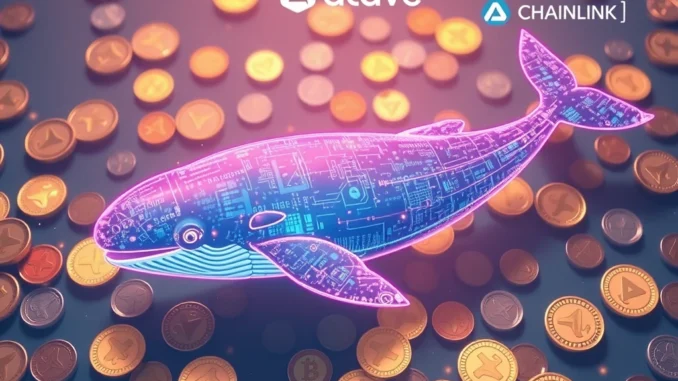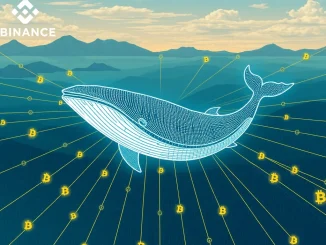
The volatile world of cryptocurrency never ceases to amaze, and recent on-chain activities have once again put the spotlight on the intriguing behavior of crypto whales. Just when you thought you’d seen it all, a fascinating development has emerged involving a whale previously impacted by the turbulent tides of decentralized exchange Hyperliquid. This crypto heavyweight, known for taking on high-leverage positions, experienced a liquidation event on Hyperliquid, but has now strategically shifted gears. In a remarkable turn of events, this same whale has leveraged the power of decentralized finance (DeFi) protocol Aave to borrow a substantial 110,000 LINK tokens. What’s even more noteworthy is the method employed: using Wrapped Ethereum (WETH) as collateral. Let’s dive deep into this captivating on-chain saga and explore the implications for the crypto ecosystem.
Decoding the Whale’s Strategy: Why Borrow LINK on Aave?
The initial report from on-chain analyst @ai_9684xtpa paints a picture of resilience and strategic maneuvering. After facing liquidation on Hyperliquid, many might expect a period of inactivity or cautious retreat. However, this crypto whale has demonstrated a different approach, showcasing the dynamic and often unpredictable nature of large crypto players. But why choose to borrow LINK, and why Aave? Let’s break down the potential motivations:
- Potential Bullish Outlook on Chainlink (LINK): Borrowing a significant amount of LINK suggests a bullish perspective on its future price. Whales often make calculated moves based on market analysis and anticipated trends. This borrowing activity could indicate an expectation of LINK’s price appreciation in the near future.
- Leverage for Trading or Staking Opportunities: Borrowed LINK can be utilized for various purposes. The whale might be planning to engage in trading activities, seeking to profit from short-term price fluctuations. Alternatively, they could be exploring staking opportunities within the Chainlink ecosystem or other DeFi platforms to generate yield on the borrowed LINK.
- Diversification and Risk Management: While seemingly counterintuitive after a liquidation, borrowing can also be part of a sophisticated risk management strategy. By using WETH as collateral on Aave to borrow LINK, the whale might be diversifying their portfolio and hedging against potential risks in other assets.
- Capitalizing on Aave’s Lending Rates: Aave offers competitive lending rates, and borrowing against WETH can be an efficient way to access liquidity without selling ETH holdings. This allows the whale to maintain their ETH exposure while gaining access to other assets like LINK.
Aave: The DeFi Powerhouse Enabling Whale Maneuvers
Aave stands out as a leading decentralized liquidity protocol, and it’s no surprise that whales and retail users alike flock to its platform. But what makes Aave such a crucial player in the DeFi space?
| Feature | Benefit |
|---|---|
| Decentralized Lending and Borrowing | Eliminates intermediaries, offering transparent and permissionless access to financial services. |
| Wide Range of Supported Assets | Users can lend and borrow a diverse portfolio of cryptocurrencies, including ETH, WETH, LINK, and stablecoins. |
| Competitive Interest Rates | Aave’s algorithmic interest rate model adjusts based on supply and demand, often providing attractive rates for both lenders and borrowers. |
| Flash Loans | Unique feature allowing users to borrow assets without collateral, provided the loan is repaid within the same transaction block – popular for arbitrage and other advanced DeFi strategies. |
| Security and Audits | Aave prioritizes security with rigorous audits and community governance, building trust and reliability. |
In this instance, Aave provides the perfect infrastructure for the whale to execute their strategy. By depositing WETH as collateral, the whale can borrow LINK, leveraging the protocol’s robust and secure lending mechanism. This highlights the power of DeFi platforms in empowering sophisticated financial operations within the crypto ecosystem.
WETH as Collateral: A Deep Dive into Wrapped Ethereum
The choice of WETH as collateral in this transaction is also significant. Wrapped Ethereum (WETH) is essentially an ERC-20 token representing ETH. Why use WETH instead of ETH directly?
- ERC-20 Compatibility: Many DeFi protocols, including Aave, are built on the Ethereum network and primarily interact with ERC-20 tokens. WETH allows ETH to be seamlessly integrated into these protocols, as native ETH does not directly conform to the ERC-20 standard.
- Seamless DeFi Integration: WETH enables ETH holders to participate in the vast DeFi ecosystem, including lending, borrowing, trading on decentralized exchanges (DEXs), and yield farming, without needing to bridge or convert assets across different chains.
- Liquidity and Acceptance: WETH is widely accepted and highly liquid across DeFi platforms. Its standardized format makes it easily tradable and usable in various smart contracts and applications.
- Simplifies Smart Contract Interactions: For developers, WETH simplifies the process of building smart contracts that interact with ETH within the ERC-20 ecosystem.
By using WETH as collateral, the whale leverages the interoperability and DeFi-friendliness of this tokenized version of Ethereum to efficiently access liquidity and borrow LINK on Aave.
Hyperliquid Liquidation: Understanding the Backstory
The narrative begins with a liquidation event on Hyperliquid. While the specifics of the leveraged position aren’t detailed in the initial report, understanding liquidations is crucial to grasp the context of this whale’s subsequent move. In the realm of leveraged trading, liquidations occur when a trader’s position is forcibly closed by the exchange to prevent further losses. This typically happens when the value of the trader’s collateral falls below a certain maintenance margin due to adverse price movements.
Key aspects of liquidations in leveraged trading:
- Leverage Amplifies Gains and Losses: Leverage allows traders to control larger positions with a smaller amount of capital. While this can magnify profits, it also amplifies potential losses.
- Margin Requirements: Exchanges require traders to maintain a certain margin (collateral) to keep leveraged positions open. This margin acts as a buffer against potential losses.
- Liquidation Threshold: If the value of the collateral falls below the maintenance margin, the position becomes at risk of liquidation.
- Automatic Closure: To protect both the exchange and other traders, the exchange automatically closes (liquidates) the position to prevent the trader from falling into negative equity.
The fact that this whale experienced liquidation on Hyperliquid underscores the inherent risks associated with high-leverage trading, even for sophisticated players. However, their swift pivot to Aave and strategic borrowing of LINK demonstrates a proactive and potentially recovery-oriented approach.
Actionable Insights and Takeaways for Crypto Enthusiasts
What can we learn from this whale’s activity? Here are some actionable insights for crypto enthusiasts and investors:
- DeFi Offers Powerful Tools: This scenario highlights the versatility and power of DeFi platforms like Aave. They provide users with sophisticated financial tools for borrowing, lending, and managing crypto assets, enabling complex strategies beyond simple buying and holding.
- Whale Activity as Market Signals: Monitoring on-chain whale activity can offer valuable insights into market sentiment and potential future price movements. Large transactions and strategic shifts by whales can sometimes foreshadow broader market trends.
- Risk Management is Paramount: Even experienced whales are not immune to market volatility and risks like liquidations. This underscores the importance of robust risk management strategies in crypto trading and investment, including appropriate leverage levels and diversification.
- Continuous Learning and Adaptation: The crypto space is constantly evolving. Staying informed about new protocols, strategies, and market dynamics is crucial for navigating this dynamic landscape successfully. This whale’s ability to adapt and strategize after a setback is a testament to the importance of continuous learning.
Conclusion: A Whale’s Bold Move in the DeFi Ocean
The tale of the Hyperliquid whale borrowing 110,000 LINK on Aave after a liquidation event is more than just an on-chain observation; it’s a captivating glimpse into the high-stakes world of crypto finance. It showcases the resilience, strategic thinking, and rapid adaptability of large crypto players. This episode underscores the transformative potential of DeFi, offering powerful tools and opportunities, while also serving as a stark reminder of the inherent risks and the critical need for astute risk management in the ever-evolving crypto ocean. As we continue to watch these digital leviathans navigate the crypto currents, their moves provide invaluable lessons and insights for all participants in this dynamic market. The whale’s bold move is a testament to the exciting and often unpredictable nature of cryptocurrency, leaving us to wonder what strategic maneuvers they will unveil next.



